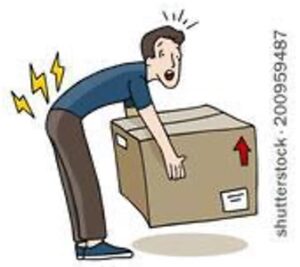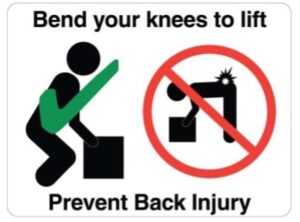
Why Back Care Matters
Back pain is a major cause of lost workdays and represents (on average) nearly a quarter of lost-time injuries and half of all compensation costs, both long-term and short term.
Your back is not like other tools that you can replace when they’re damaged. Once you have injured your back, it will affect both your work life and your home life. Prevention of back pain costs much less than the treatment of back pain and can have a major impact on the general quality of life of many workers.
There are 33 vertebrae in your back that are separated by discs and held together by ligaments. The back has many different muscles to hold all the vertebrae together. Three curves make up your back – cervical (neck), thoracic (mid-back) and lumbar (lower back)). Unless you are standing in a natural position, with your ears, shoulders and hips all aligned, your spine is under some type of stress.
Almost everyone has suffered back pain at some time. Common causes include but are not limited to sitting improperly, heavy lifting, falls, motor vehicle incidents and whole body vibration. To understand how often the back is used, just think that every time you bend, your back lifts approximately 70% of your body weight even when you aren’t lifting anything.
If you don’t set up and maintain a regular exercise program, with some emphasis on back and abdominal strengthening and stabilization, the wear and tear can worsen and cause back problems even earlier. Without a regular exercise program, a simple activity such as reaching for the phone can trigger a back problem.
Research indicates that workers are much less likely to suffer an injury if they have been trained to recognize high-risk tasks and have the knowledge necessary to modify the task or ask for the task to be modified. This is why a Musculoskeletal Disorder Prevention Program (Ergonomic Program) is so important.
Back Care and Lifting
Lifting Safely
Here are some important tips regarding lifting:
- Start by assessing the shape and size of the load. If you think you will be unable to do it on your own, ask for help. (A two-person lift is preferable for weight distribution and manoeuvring capabilities.)
- Make sure the load is free or loose and able to be moved.
- Check the travel route to make sure it is free of obstacles, debris and any slip or trip hazards.
- Keep the load close to your body.

- Do not twist while handling the load, as this will place extreme strain on your back.
- Make sure you have firm footing, a wide stance, good grip and keep your arms straight.
- Bend your knees as much as possible. If the load is large, you may have to stand slightly over it to start the lift.
- Tighten your abdominal muscles and try to tuck your chin into your chest.
- Initiate the lift with your body weight and lift with your legs, as they are a larger and stronger muscle group.
- If you are unable to use a smooth and slow lifting approach, use momentum to help bring the load closer to your body.
General advice about lifting
- If tools are required to help with the lift, make sure they are in good working order before you use them.
- Use proper-fitting and appropriate hand protection whenever possible.
- Do not use a tight grip when lifting, as this causes more stress and fatigue in your wrist and forearm muscles and tendons.
Specific lifting advice
- For small compact loads: Bend with your knees, keep your back straight and lift with your legs.
- For large loads: Maintain the natural curve in your spine as much as possible, stick your behind out and tighten your abdominal muscles. This will enhance the natural curve in your lower back and keep your back muscles strong.
- For a two-person lift: Make sure there is clear communication and coordination between you and the other lifter. It’s a good idea to simulate the lift before attempting the task.
Hazards when lifting: there are many hazards that need to be considered when lifting
 General hazards:
General hazards:
- Type of material being lifted
- Environmental conditions
- Posture and technique
- Individual characteristics
Back Care and Lifting
Material hazards:
· Weight · Shape · Size · Surface irregularities · Absent or inappropriate handles Postural hazards: · Imbalance · Repetition · Duration · Poor posture · Poor movement · Distance Individual hazards: · General health, including age · Height · Size · Flexibility · Strength · Weight · Pre-existing musculoskeletal problems or injuries · Motivation · Stress
